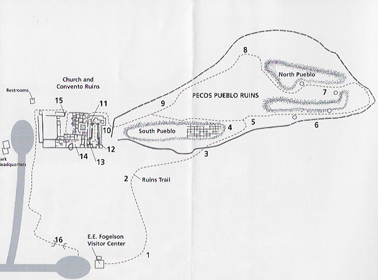
Location
1. On church wall near #11 (GPS-N35D32'59.862 X W105D41'20.957)
2. Throughout the trail (major patch between #3 & #6 at kiva)
Flowers first observed: 4/3/17
The Plant w/Flowers
 |
 |
The Flowers
 |
 |
Flower w/seed pods |
50X |
Distribution
"Flixweed tansymustard is native to Europe and northern Africa. It now occurs in 48 states, excluding Alabama and Florida [72]. Its distribution extends south to Baja California, and as far north as 70o N latitude in Greenland, Alaska, and Canada. It occurs throughout Canada except Labrador and eastern Nunavut [69,72,133,147]. Plants database provides a distributional map of flixweed tansymustard in the United States and Canada." (U.S. Forest Service)
Description
"Descurainia sophia is a member of the mustard family.[1] Common names include flixweed, herb-Sophia and tansy mustard.[2] It reproduces by seeds. Its stem is erect, branched, and 4 to 30 inches high.[3] It was once given to patients suffering from dysentery and called by ancient herbalists Sophia Chirurgorum, "The Wisdom of Surgeons," on account of its healing properties.[4] It is the type species of the genus Descurainia and of the rejected genus Sophia Adans.[5][6].
In German, it is called the Sophienkraut and associated with Saint Sophia of Rome, who was invoked against late frosts.[7]" (Wikipedia)
Ethnobotanical Uses
Food:
"Kawaiisu Beverage Seeds parched, pounded, sifted, mixed with cold water, and taken as nourishing beverage. Winter Use Food Pounded or raw seeds stored for future use. Navajo, Ramah Bread & Cake Ground seeds used to make cakes. Fodder Used as sheep feed. Paiute Beverage Roasted, ground seeds mixed with water and used as a cooling beverage for hot weather. Ice Cream Seeds mixed with snow and eaten as ice cream. Staple Seeds parched, ground, and eaten as a meal. Paiute, Northern Beverage Seeds dried, cooked, ground, water added kneaded, water added to make a fine batter, and drunk. Unspecified Seeds roasted ,cooled, ground, mixed with cold water, and eaten. Winter Use Food Seeds stored for winter use. Pueblo Dried Food Young plants boiled, pressed, rolled into balls, dried, and stored for winter use. Soup Plant made into a stew with wild onions, wild celery, tallow, or bits of meat. Unspecified Young plants boiled, pressed, rolled into balls,and eaten. Vegetable Young plants boiled with a pinch of salt and eaten as greens."(Moerman 198)
"Leaves are mildly spicy, but somewhat dry textured, so it is best to combine them with others, fresh, in salads. Cook in stir-fries, casseroles, soups, omelets, bean dishes, and quiche. Excessive cooking reduces spiciness. Also, seeds are edible and sproutable." (Seebeck 93)
"Tender young shoots provide a zesty addition to salads and sandwiches, and stronger plants are best used as flavoring in soups, salads and casseroles." (Kershaw 120)
Medicine:
"Navajo, Ramah Toothache Remedy Poultice of plant applied for toothache. Paiute Dermatological Aid Poultice of ground seeds applied to burns and sores, including sores on horses. ---"(Moerman 198)
"These plants are rich in vitamins A, B and C and also contain considerable amounts of trace minerals. The seeds, which are said to stimulate the production of digestive juices, have been used for many years as an aid for digestion. --- Mustard seed has also been used in poultices for healing wounds, and it was sometimes taken in large quantities as a laxative." (Kershaw 120)
Other:
"Keres, Western Fertilizer Leaves buried with seed corn as a fertilizer or fungicide. Infusion of plant used to soak seed corn for faster maturity. Preservative Leaves stored with corn to prevent spoiling."(Moerman 198-9)
"Tansy mustard is used to produce pottery paint and is prepared in much the same way as guaco (the paint made from Rocky Mountain beeplant). Descendants of the former inhabitants of Pecos Pueblo have been successful in duplicating the lead glaze designs on pottery once used there: seeds of tansy mustard are ground in a mortar until an oily liquid forms; this liquid is then mixed with iron pigment and used to paint patterns on the pottery." (Dunmire and Dunmire 181)
Internet Links